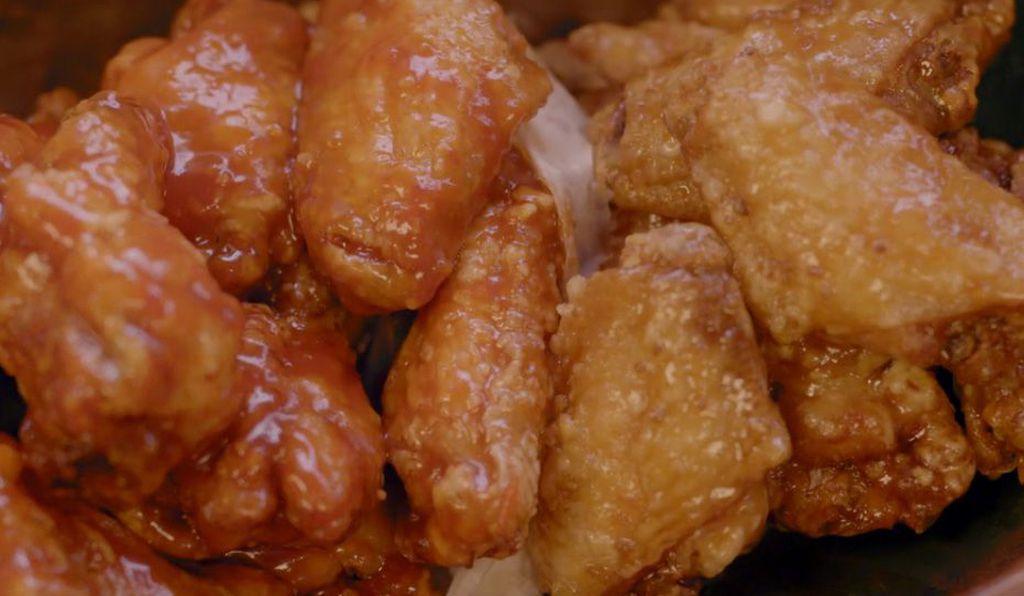In South Korea today, many people celebrate on payday or on Friday night with fried chicken, but it is not limited to these occasions. I order fried chicken delivery when feeling lazy, sleeping over with friends, or watching soccer or baseball games.
Fried chicken is a ubiquitous staple in the lives of many Koreans. It was the cliché of a happy family in Korean TV dramas. As a young girl, I dreamed of my father coming home and saying, “Hey kids, I brought fried chicken!” I remember once asking my father if he really loves us, since he never came home with a box of chicken.
Since its inception, the cooking style, ingredients, and taste of Korean fried chicken have evolved. Some scholars claim that the U.S. military presence after the Korean War introduced deep-fried chicken to the Korean palate. In the 1960s and ’70s, Western-style rotisserie chicken restaurants became popular in urban areas. Starting in the 1980s, Korean-style fried chicken dipped in a sweet and spicy sauce made with gochujang (fermented chili paste) was delivered to virtually every household in modern apartment complexes. American franchises KFC and Popeye’s were designed for a dining-in experience in the South Korean market.
The 1997 Asian financial crisis contributed to the craze, as many laid-off workers opened fried chicken restaurants to earn a living. What is often referred to as Korean fried chicken in the United States—a thin cornstarch coating with soy garlic or sweet and spicy sauce—is one of the recipes developed during this period.
This 1990s-style Korean fried chicken would not have been created without this U.S.-Korea culinary exchange, yet it took about two decades for it to make its way into the American food scene.
Karen Park and Young-Jun Park, a Korean American immigrant family living in Washington, D.C., recognized the growing popularity of Korean fried chicken. After running fish and chips restaurants for almost two decades, they made the risky decision to sell Korean food in a neighborhood outside of the Asian ethnic enclave. As the Hallyu or “Korean wave” of K-pop music and K-dramas spread globally, the Parks believed the American palate was ready to explore their Korean-style dishes.
In 2013, they opened KoChix, a now popular restaurant in the Shaw neighborhood of Washington, D.C. In the evenings and weekends, the entrance bell rings every thirty seconds as people line up to taste this delicious dish. The crunchy texture and sweet flavor of their fried chicken, deliciously sweetened to appeal more to American tastes, has been nicknamed “candy chicken” by their customers.
To enhance crispiness even with the sticky sauce applied, KoChix’s fried chicken requires double the effort. Their marinated wings and drums are coated twice with dry and wet batter. They are deep-fried twice to preserve moisture of the meat and make the exterior crispy. Lastly, they brush on honey and apply one of three special Korean-style sauces: soy garlic, honey spicy, and hot honey spicy sauces. These sauces resemble the Korean fried chicken sauces in the ’80s and ’90s and bring back my memories of growing up in South Korea, while expanding the taste buds of non-ethnic Koreans, who make up the other 90 percent of their clientele.
“It is a home meal,” Karen Park explained, even though it’s purchased in their shop. “Our customers take out our fried chicken and share it with their families and friends at home.”
The shop also caters to neighborhood construction workers, who order burgers, Philly cheesesteaks and French fries at lunchtime. They sell other Korean dishes, such as bibimbap, bulgogibap, and handmade gunmandu (called yakimandu on the menu, they are fried dumplings brushed with soy garlic sauce). American and Korean tastes blend together—that is KoChix’s culinary thumbprint.
Something similar happens among the restaurant staff, all of different cultural backgrounds but bonding over shared experiences in the kitchen. Washington area native Gerald Skinner enthusiastically explains Korean dishes to those unfamiliar. Hailing from El Salvador, Ricardo Portillo has worked at Korean restaurants in the past and has mastered deep-frying chicken and gunmandu. Eden Asmare, from Ethiopia, specializes in griddle cooking such as bulgogi. Although these staff members may not share the same memories of fried chicken as the Parks, they are creating their own attachments to Korean food.
Both the Parks and staff’s efforts have earned this mom-and-pop shop local fame, and the Washington Post recognized their hard work and the quality of their food. To this day, the Parks are grateful to the food critic whose review contributed to the popularity of their restaurant outside of their neighborhood.
The story of KoChix epitomizes how immigrants can transcend ethnic food boundaries and cater to other communities. Before opening their store, the Parks had long been unable to incorporate their own culinary identity into their business. Now KoChix’s Korean fried chicken serves as an example of how a dish can be transformed in a new land, and how it can bring together people from disparate cultures and backgrounds.
A version of this article originally appeared in the online magazine of the Smithsonian Center for Folklife and Cultural Heritage.
Cecilia Peterson is the digital projects archivist in the Ralph Rinzler Folklife Archives and Collections at the Center for Folklife and Cultural Heritage. The daughter of a Swedish father and Cuban mother, her family’s home cooking was how she explored her roots growing up. Her best days are spent at the confluence of food, culture, and good company in the kitchen.
Crystal H. Rie is an M.A. student of Asian studies at Georgetown University and a Smithsonian graduate student fellow, exploring the historical process of introduction and transformation of Korean cuisine in the United States. Born and raised in South Korea, she is particularly interested in examining national identity, globalization, and soft power through the lens of food.





